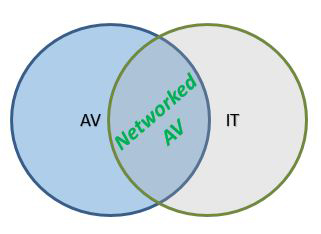Five Reasons AV Needs to Become More IT
 Last week, I read a very good article titled The Five Reasons Why AV is Not IT by Ernie Beck. The article discussed in a very compelling way how AV has considerable value in systems integration and will continued to for a long time to come. One of the great points in this article is that for the integrators and systems design engineers that embrace their true value add there is plenty of value in their contribution and still plenty of business to be had. There was a theme of “don’t sell yourself short.” In the article/blog I am writing here I intend on building on that necessary message for all AV systems integrators to maintain the message that they own the physical space and no IT integrator or reseller can match the user experience they can bring. What I intend to add is the need-to-know five reasons that AV integrators should consider transitioning their business to include an IT integration element along with maintaining the value (the core competency) in acoustics, lighting, control and space planning.
Last week, I read a very good article titled The Five Reasons Why AV is Not IT by Ernie Beck. The article discussed in a very compelling way how AV has considerable value in systems integration and will continued to for a long time to come. One of the great points in this article is that for the integrators and systems design engineers that embrace their true value add there is plenty of value in their contribution and still plenty of business to be had. There was a theme of “don’t sell yourself short.” In the article/blog I am writing here I intend on building on that necessary message for all AV systems integrators to maintain the message that they own the physical space and no IT integrator or reseller can match the user experience they can bring. What I intend to add is the need-to-know five reasons that AV integrators should consider transitioning their business to include an IT integration element along with maintaining the value (the core competency) in acoustics, lighting, control and space planning.
- Products and Solutions are Being Driven to IT — AVB, Dante, VOIP, H.264, H.265 and many other standards are driving technology development. This development is leading the AV industry down the path of being incredibly more IT centric. The challenge lies in that knowledge of streaming protocols, multicast implementation, layer 2 and layer 3 switching requirements and many other standards and implementation requirements are often unknown to standard IT people. The ways AV leverages IT are different than IT is used to and the value an AV integrator can bring can be considerable if they bring this specialization. It has been said recently that we are not in the AV business, we are in the technology business. It is time to grow into the IT side, this is where AV can shine and add a lot of value in IT.
- End Users and Buyers Expectations are Evolving — Many times a connection between what an end users sees at home or out in the market in many other segments lets them see what should or could be done for them in their boardroom or conference rooms and meetings spaces. The mentality becomes “if they can do this (insert technical feat accomplished in home) why can’t they do that (insert technical feat done in office)” or “if this works and that works then why can’t they make this plus that?” The knowledge and complexity of the end user and their expectations drive us as a market to deliver on a higher level. An additional challenge is that with these increased expectations is that AV has hit somewhat of a critical mass. AV can’t deliver much more than they already are without leveraging the network or the use of some new technology.
- IT is Looking Outwardly for Expertise — In 2015 there was a considerable shift in IT where the IT Generalist was the top growing level of certification and the top job position being filled/sought by recruiters. IT departments, strategist and hiring managers have recently realized that they need people with a broader understanding of IT and that they could then later deploy specialized skills only when needed. This shows us that IT now has a better understanding of when to bring in outside resources to solve unique problems. AV/IT integration is still a very unique problem that AV integrators can be that specialized force that IT is looking for.
- IT is Lower Cost and IT is a Different Funding Source — I will write an entirely different article on the details of this in the near future, but suffice it to say that AV ports tend to run about $350 per port for switching and a Gigabit Ethernet ports run $25 to $30 for switching. Traditionally AV has found its funding through facilities. The beauty of IT is that IT has a completely separate budget and as long as you can prove the business need and the increase in profitability and productivity then that budget is easily and justifiably invested into AV/IT.
- Increased Functionality — Simply by adding AV over IT one can route their video from anywhere to anywhere using the network infrastructure. Control and full integration is seamless. This is far beyond seeing every device and controlling it over the network. This is fully converged where data, AV and control all reside on the same network (segmented via VLANs or whatnot) and when the customer needs they can have AV and data (say a video call with customer information on the same screen). This can be deployed in unbelievable ways to bring a whole new world of AV/IT solutions. In addition to the freedom in routing one can add functionalities such as video wall processing, windowing, control, and recording and much more simply by adding AV/IT appliances to the network.





